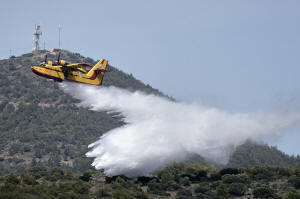|
“It is clear that the conditions this year will be particularly
difficult,” Kefalogiannis told reporters after attending a
firefighting exercise south of Athens.
Rising average temperatures and low rainfall have significantly
worsened conditions in recent years.
Greek Fire Chief Lt. Gen. Theodoros Vagias told The Associated
Press that additional elite firefighting units would be deployed
to high-risk areas during the May 1–Oct. 31 fire season.
“The climate crisis is here to stay, and we must be more
effective in surveillance, preparedness, and how we mobilize our
resources,” Vagias said.
Wildfire damage surged to more than 1,300 square kilometers (500
square miles) in 2021 and 1,745 square kilometers (675 square
miles) in 2023 — roughly three times the 2011–2020 average —
according to data from the European Union’s Forest Fire
Information System.
Firefighters held an exercise Thursday to test Greece’s evolving
wildfire response, which increasingly relies on advanced
technologies such as drone surveillance and mobile command
centers.
Fire planes skimmed treetops, releasing plumes of water in
coordinated low-altitude drops, as commanders on the ground
huddled over tablets streaming real-time drone footage. The
coast guard and armed forces took part in a drill simulating the
evacuation of a children’s summer camp threatened by fires on
multiple fronts.
Officials said the number of firefighting personnel has
increased by roughly 20% over the past two years, while the
fleet of fire-surveillance drones has grown to 82, up from 45.
Around 300 firefighters from the Czech Republic, France,
Romania, Moldova, and Bulgaria are being sent to Greece under a
European Union prepositioning program, officials said.
__ Lefteris Pitarakis in Lavrion, Greece contributed to this
report
All contents © copyright 2025 Associated Press. All rights
reserved |
|




